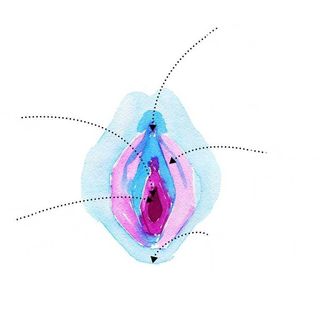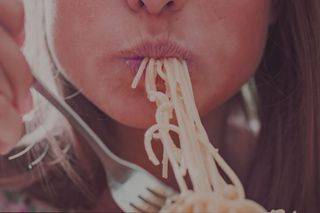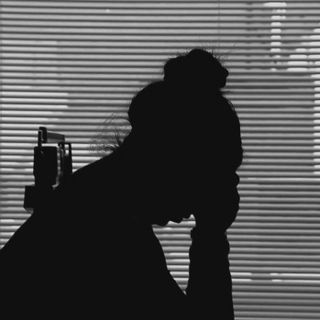
Could Intuitive Eating End Diet Culture?
A change in how people view food could heal disordered eating and de-prioritize getting skinny.

In an essay for the New York Times, bestselling author Jessica Knoll details her long struggle with disordered eating until she found a dietician who said of eating, “It’s one of the greatest pleasures in life. Can you think of your appetite as a gift?”
Body positivity teaches us that an enthusiastic “yes!” to the above question should be the norm. But there is a difference between knowing what to think and knowing how to think it. The terror of fat pooling under skin, stuffed bellies under screaming buttons, wobbly arms, and watchful judgment from everyone everywhere is ingrained enough to never make thinking “yes!” instinctive. This keeps people stuck in the cycle of crash diets and inaccurate calorie counting, designed to fix bodies through food restriction and weight loss.
However, intuitive eating, with its focus on breaking patterns of disordered eating, is currently the best challenge to years of unhealthy diet culture. Intuitive eating is the anti-diet because it is designed to heal rather than fix.
Related on The Swaddle:
The Therapy That Explores Our Deep, Dark Relationship With Food
Intuitive eating is a self-care framework that integrates instinct, emotion, and rational thought to help us get to that “yes.” Brought to prominence in 1995 by Evelyn Tribole and Elyse Resch, intuitive eating is a healing process via which a person can get back in sync with their body’s cues about hunger and fullness. It’s no-frills eating: one can eat what their body desires when their body desires. There are no specific cookbooks, shakes, powders, or potions that must be consumed as a ‘fix’ to a weight problem. The co-founders don’t sell anything but their books and workshops. While intuitive eating might seem like yet another diet trend due to the overwhelming amount of ways people are told to carry out fundamental activities like eating — it is definitely not a diet. The process of intuitive eating involves listening and catering to the direct messages the human body sends regarding hunger to meet physical and psychological needs — which also means the process does not place any priority on thinness.
Instead, intuitive eating employs a 10-step process that begins by helping an individual make peace with their appetite; then, it introduces respect for one’s body via exercise and adequate nutrition. The process is weight-neutral, has a validated assessment scale and does not endorse diets, food plans, calorie counting or any other form of restrictive eating.
A common point of criticism about the veracity of intuitive eating is — how does eating as you please counter disordered eating? Wouldn’t multiple donuts a day, or a large bowl of pasta add to the ‘problem’ rather than ‘fix’ it? The truth is, disordered eating is a direct result of restriction rather than free choice. Eating disorders like bulimia nervosa, anorexia nervosa, and binge eating disorder are the results of extreme food deprivation.
Without restriction, the mind’s interest in a binge-able food item drops drastically. “It’s the permission paradox,” Tribole told The Atlantic. “When you have permission to eat, the food still tastes good, but you remove the urgency.” The ideal eating space to be in is a mild fluctuation between want and dislike for almost all food items.
Related on The Swaddle:
Crash Dieting May Give You More Belly Fat, High Blood Pressure
Steps like “honoring your hunger” and “challenging the food police” help individuals stuck in binge/fast cycles to break free by just eating whatever they want, regardless of how healthy it is. This could come across as unhealthy, at first look, but the point is to impact both physical and emotional health: Treating all food merely as food, rather than ascribing values to different items (e.g. ‘cheat meals’ or ‘junk food’), strips the eating process of any crime-and-punishment cycle. When that relationship is gradually repaired, a new relationship is built with nutrition and exercise.
All of this could result in reaching one’s desired weight. Or, “if a person has been restricting forever, it’s possible that they see weight changes and weight gain when they become more attuned to what their needs are,” Kathleen Meehan, a registered dietitian, told Refinery29.
Regardless, neither is the goal of intuitive eating. The goal is to make working out or packing a salad for lunch a routine, caring response to the body’s needs — not an obligation for being healthy.
While intuitive eating can be done without the help of a dietician and/or therapy, it’s hard; a large amount of introspection and feedback is necessary to break a lifetime of conditioning and build a new outlook toward food from scratch. This holds especially true for those coping with eating disorders. The lack of external gratification — i.e. dropping sizes and shrinking waistlines — can be demotivating. As dietary quick fixes beckon relentlessly via social channels, the patience required to ignore them is also difficult when dealt with alone.
With its focus on improving people’s relationships with food, intuitive eating could actually end diet culture. Too many have told us what, when and how to put food into our gullet. Perhaps its time to turn those tables and listen to our bodies again.
Aditi Murti is a culture writer at The Swaddle. Previously, she worked as a freelance journalist focused on gender and cities. Find her on social media @aditimurti.
Related


Natural Decline in Fertility Observed for Men Over 51
